Neonatal Abandonment and Hydrocephalus in Antillean Manatees (Trichechus manatus manatus): Is There a Causal Relationship?
Abstract
Simple Summary
Abstract
1. Introduction
2. Materials and Methods
3. Results
4. Discussion
5. Conclusions
Author Contributions
Funding
Institutional Review Board Statement
Informed Consent Statement
Data Availability Statement
Conflicts of Interest
References
- Hartman, D. Ecology and Behavior of the Manatee (Trichechus manatus) in Florida; American Society of Mammalogists: Cambridge, MA, USA, 1979; Volume 5, p. 153. [Google Scholar]
- Marsh, H.; O’shea, T.J.; Reynolds, J.E., III (Eds.) Behavior and Habitat use. In Ecology and Conservation of the Sirenia: Dugongs and Manatees; Cambridge University Press: Cambridge, UK, 2011. [Google Scholar]
- Marmontel, M.; Odell, D.K.; Reynolds, J.E., III. Reproductive Biology of South American Manatees. In Reproductive Biology of South American Vertebrates; Hamlett, W.C., Ed.; Springer: New York, NY, USA, 1992. [Google Scholar]
- Bonde, R.K. Sirenian life history. In Encyclopedia of Marine Mammals; Würsig, B., Thewissen, J.G.M., Kovacs, K.M., Eds.; Academic Press: Cambridge, MA, USA, 2018. [Google Scholar]
- Reep, R.L.; Bonde, R.K. The Florida Manatee Biology and Conservation; University Press of Florida: Gainesville, FL, USA, 2021. [Google Scholar]
- Tennant, S.M.; Hazelkorn, R.A. Epimeletic behavior in a Florida Manatee. Sirenews 2019, 70, 26–28. [Google Scholar]
- O’Shea, T.J.; Beck, C.A.; Hodgson, A.J.; Keith-Diagne, L.; Marmontel, M. Chapter 4–Social and Reproductive Behaviors in Ethology and Behavioral Ecology of Sirenia; Marsh, H., Ed.; Springer Nature Switzerland AG: Cham, Switzerland, 2022. [Google Scholar]
- Lima, R.P. Peixe-boi marinho (Trichechus manatus): Distribuição, Status de Conservação e Aspectos Tradicionais ao longo do litoral nordeste do Brasil. Mestrado Dissertação, Oceanografia Biológica, Universidade Federal de Pernambuco, Recife, Brazil, 1997. 87f. [Google Scholar]
- Parente, C.L.; Vergara-Parente, J.E.; Lima, R.P. Strandings of Antillean manatees (Trichechus manatus) in northeastern Brazil. Lat. Am. J. Aquat. Mamm. 2004, 3, 69–76. [Google Scholar] [CrossRef][Green Version]
- Arraut, E.M.; Marmontel, M.; Mantovani, J.E.; Novo, E.M.L.M.; Macdonald, D.W.; Kenward, R.E. The lesser of two evils: Seasonal migrations of Amazonian manatees in the Western Amazon. J. Zool. 2010, 280, 247–256. [Google Scholar] [CrossRef]
- Calvimontes, J.; Marmontel, M. Hunting and hunters of the Amazonian manatee in a Brazilian protected area. Lat. Am. J. Aquat. Mamm. 2022, 17, 113–128. [Google Scholar] [CrossRef]
- Bonde, R.K. Population Genetics and Conservation of the Florida Manatee: Past, Present and Future. Ph.D. Dissertation, University of Florida, Gainesville, FL, USA, 2009. [Google Scholar]
- Liu, L. Biological versus foster Antillean manatee calf: Who receives more social interaction from mother? Univ. Toronto J. Undergrad. Life Sci. 2017, 11, 30–35. [Google Scholar]
- Deutsch, C.J.; Self-Sullivan, C.; Mignucci-Giannoni, A. Trichechus manatus. The IUCN Red List of Threatened Species 2008: (e.T22103A9356917). Available online: https://www.iucnredlist.org/species/22103/9356917 (accessed on 25 April 2024).
- Luna, F.O.; Balensiefer, D.C.; Fragoso, A.B.; Stephano, A.; Attademo, F.L.N. Trichechus manatus Linnaeus, 1758, p. 103–109. In Instituto Chico Mendes de Conservação da Biodiversidade (orgs). Livro Vermelho da Fauna Brasileira Ameaçada de Extinção: Volume II–Mamíferos; ICMBio/MMA: Brasília, Brazil, 2018; 625p. [Google Scholar]
- Attademo, F.L.N.; Miranda, A.V.; Torres-Florez, J.P.; Sousa, G.P.; Fruet, P.F.; Luna, F.O. (Orgs). Atendimento a Peixes-Bois Encalhados e Transporte de Filhotes; ICMBio: Brasíliam Brazil, 2022; 58p. [Google Scholar]
- Normande, I.C.; Attademo, F.L.N.; Luna, F.O.; Soorae, P.S. Antillean manatee release program in Brazil. In Global Re-Introduction Perspectives; IUCN: Gland, Vaud, Switzerland, 2016; pp. 162–165. [Google Scholar]
- Attademo, F.L.N.; Oliveira, R.E.M.; Sousa, G.P.; Luna, F.O. Doenças infecciosas e não infecciosas nos peixes-boi do Brasil. Acta Sci. Vet. 2020, 48, 1768. [Google Scholar]
- Carvalho, V.L.; Groch, K.R.; Catão-Dias, J.L.; Meirelles, A.C.O.D.; Silva, C.P.N.; Monteiro, A.N.B.; Díaz-Delgado, J. Cerebral and cardiac congenital malformations in neonatal West Indian manatees (Trichechus manatus). J. Comp. Pathol. 2019, 166, 29–34. [Google Scholar] [CrossRef]
- Cantile, C.; Youssef, S. Nervous System in Jubb, Kennedy, and Palmer’s Pathology of Domestic Animals; Maxie, M.M., Ed.; Elsevier: Amsterdam, The Netherlands, 2016. [Google Scholar]
- Bonde, R.K.; Beck, C.A.; O'shea, T.J. Manual of Procedures for the Salvage and Necropsy of Carcasses of the West Indian Manatee (Trichechus manatus); Denver Wildlife Research Center: Gainesville, FL, USA, 1983. [Google Scholar]
- Behmer, O.A.; Tolosa, E.M.C.; Neto, A.G.F.; Rodrigues, J. Manual de Técnicas para Histologia Normal e Patológica; Editora Manole: São Paulo, Brazil, 2013. [Google Scholar]
- Balensiefer, D.C.; Attademo, F.L.; Sousa, G.P.; Freire, A.C.; da Cunha, F.A.; Alencar, A.E.; Silva, F.J.; Luna, F.D. Three decades of Antillean manatee (Trichechus manatus manatus) stranding along the Brazilian coast. Trop. Conserv. Sci. 2017, 10, 1940082917728375. [Google Scholar] [CrossRef]
- Bossart, G.D. Marine mammals as sentinel species for oceans and human health. Vet. Pathol. 2011, 48, 676–690. [Google Scholar] [CrossRef]
- Reynolds, J.E., III; Powell, J.A.; Keith Diagne, L.W.; Barton, S.L.; Scolard, K.M. Manatees: Trichechus manatus, T. senegalensis, and T. inunguis. In Encyclopedia of Marine Mammals; Würsig, B., Thewissen, J.G.M., Kovacs, K.M., Eds.; Academic Press: Cambridge, MA, USA, 2018. [Google Scholar]
- Martins, S.E.; Mendes, A.C. Caracterização de depósitos sedimentares recentes da porção superior da Baía de Marajó (margem leste do estuário do Rio Pará, Amazônia). Pesqui. Geociências 2011, 38, 168–180. [Google Scholar] [CrossRef][Green Version]
- Bonvicino, C.R.; Viana, M.C.; De Oliveira, E.H.; Emin, R.; De Sousa, J.; Junior, S.; Sousa, M.E.M.; Siciliano, S. Distribution of South American manatees, Trichechus manatus Linnaeus, 1758 and T. inunguis (Natterer, 1883) (Sirenia: Trichechidae). Bol. Mus. Para. Emílio Goeldi-Ciências Nat. 2020, 15, 573–599. [Google Scholar] [CrossRef]
- Domning, D.P. Distribution and status of manatees Trichechus spp. near the mouth of the Amazon River, Brazil. Biol. Conserv. 1981, 19, 85–97. [Google Scholar] [CrossRef]
- Siciliano, S.; Emin-Lima, N.R.; Costa, A.F.; Rodrigues, A.L.; Sousa, M.E.; Silva, C.R.; Souza, S.P.; Silva Júnior, J.S. Going back to my roots: Confirmed sightings of the Antillean manatee (Trichechus manatus) on the coast of Ilha de Marajó, northern Brazilian coast. J. Mar. Biol. Assoc. UK 2007, 6, 34–35. [Google Scholar]
- Bonvicino, C.R.; Viana, M.C.; de Oliveira, E.H.; Emin-Lima, R.; Silva Júnior, J.D.S.E.; Sousa, M.E.M.; Siciliano, S. Polymorphisms and distribution of South American manatees (Trichechus spp.). PeerJ Prepr. 2019, 7, e27787v1. [Google Scholar]
- Attademo, F.L.N.; Gomes, G.L.; Silva, F.J.L.; Moreira, A.B.; Freire, A.C.B.; Sá-Leitão, H.C.M.; Luna, F.O. Comportamento de Peixes-Bois–Guia Ilustrado; ICMBio: Brasília, Brazil, 2020; 47p. [Google Scholar]
- Watson, A.G.; Bonde, R.K. Congenital malformations of the flipper in three West Indian manatees, Trichechus manatus, and a proposed mechanism for development of ectrodactyly and cleft hand in mammals. Clin. Orthop. Relat. Res. 1986, 202, 294–301. [Google Scholar] [CrossRef]
- Walsh, M.T.; Bossart, G.D. Manatee medicine. Zoo & Wild Animal Medicine. Curr. Ther. 1999, 4, 507–516. [Google Scholar]
- Mignucci-Giannoni, A.A.; Montoya-Ospina, R.A.; Jiménez-Marrero, N.M.; Rodríguez-López, M.A.; Williams, E.H., Jr.; Bonde, R.K. Manatee mortality in Puerto Rico. Environ. Manag. 2000, 25, 189–198. [Google Scholar] [CrossRef] [PubMed]
- Weisbrod, T.C.; De Wit, M.; Hernandez, J.A.; Panike, A.L.; Rotstein, D.; Stacy, N.I. Manatee Trichechus manatus latirostris calf mortality in Florida: A retrospective review of pathology data from 2009–2017. Dis. Aquat. Org. 2021, 147, 111–126. [Google Scholar] [CrossRef] [PubMed]
- da Silva, V.M.; Rosas, F.C.W.; Neto, J.A.D.A.; Feldberg, E.; Franco-de-Sá, J.F.O.; Lazzarini, S.M.; de Souza Amaral, R. Oral cleft in an Amazonian manatee (Trichechus inunguis) (Mammalia, Sirenia). Lat. Am. J. Aquat. Mamm. 2024, 19, 120–124. [Google Scholar] [CrossRef]
- Santos FRBarros, H.M.D.R.; Schetino, M.A.A.; Lima, C.S. Genética in Peixe-Boi Marinho: Biologia e Conservação no Brasil; Meirelles, A.C.O., Carvalho, V.L., Eds.; Aquasis, Bambu Editora e Artes Gráficas: São Paulo, SP, Brazil, 2016. [Google Scholar]
- Gavier-Widen, D.; Wells, G.A.H.; Simmons, M.M.; Wilesmith, J.W.W.; Ryan, J. Histological observations on the brains of symptomless 7-year-old cattle. J. Comp. Pathol. 2001, 124, 52–59. [Google Scholar] [CrossRef]
- Marshall, C.D.; Reep, R.L. Manatee cerebral cortex: Cytoarchitecture of the caudal region in Trichechus manatus latirostris. Brain Behav. Evol. 1995, 45, 1–18. [Google Scholar] [CrossRef] [PubMed]
- Bauer, G.B.; Reep, R. Sirenia Sensory Systems in Encyclopedia of Animal Cognition and Behavior; Vonk, J., Shackelford, T.K., Eds.; Springer Nature Switzerland AG: Cham, Switzerland, 2022. [Google Scholar]
- Dutton, G.; Ballantyne, J.; Boyd, G.; Bradnam, M.; Day, R.; McCulloch, D.; Mackie, R.; Phillips, S.; Saunders, K. Cortical visual dysfunction in children: A clinical study. Eye 1996, 10, 302–309. [Google Scholar] [CrossRef] [PubMed]
- Mandara, M.T.; Pavone, S.; Vitellozzi, G. Internal hydrocephalus and associated periventricular encephalitis in a young fox. Vet. Pathol. 2007, 44, 713–716. [Google Scholar] [CrossRef] [PubMed]
- Kim, J.H.; Jeon, J.H.; Park, K.H.; Yoon, H.Y.; Kim, J.Y. Acute blindness in a dog with Acinetobacter-associated postencephalitic hydrocephalus. J. Vet. Med. Sci. 2017, 79, 1741–1745. [Google Scholar] [CrossRef] [PubMed]
- Murie, J. On the Form and Structure of the Manatee (Manatus americanus). Trans. Zool. Soc. Lond. 1870, 8, 127–220. [Google Scholar] [CrossRef]
- Reep, R.L.; O’Shea, T.J. Regional brain morphometry and lissencephaly in the Sirenia. Brain Behav. Evol. 1990, 35, 185–194. [Google Scholar] [CrossRef]
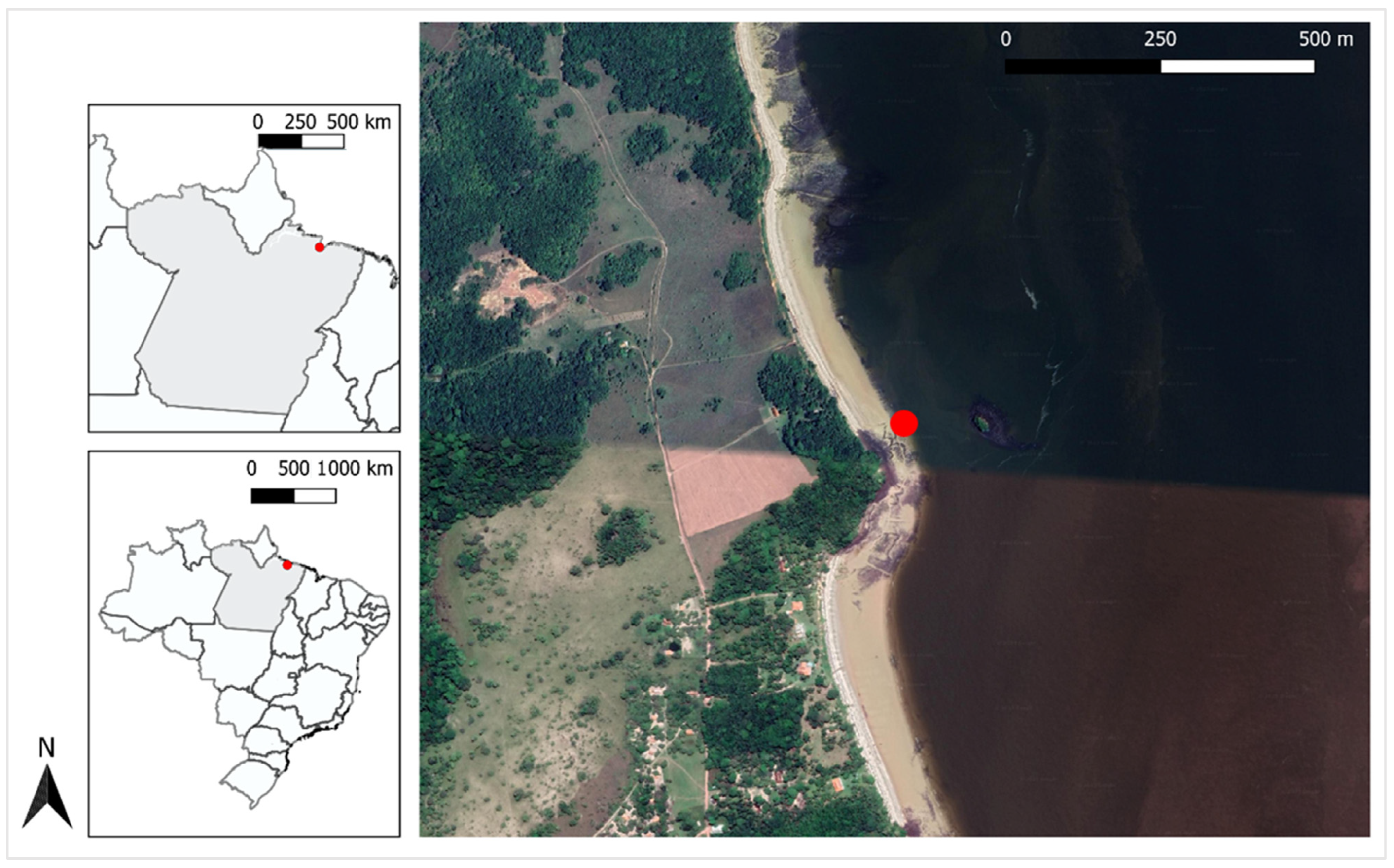
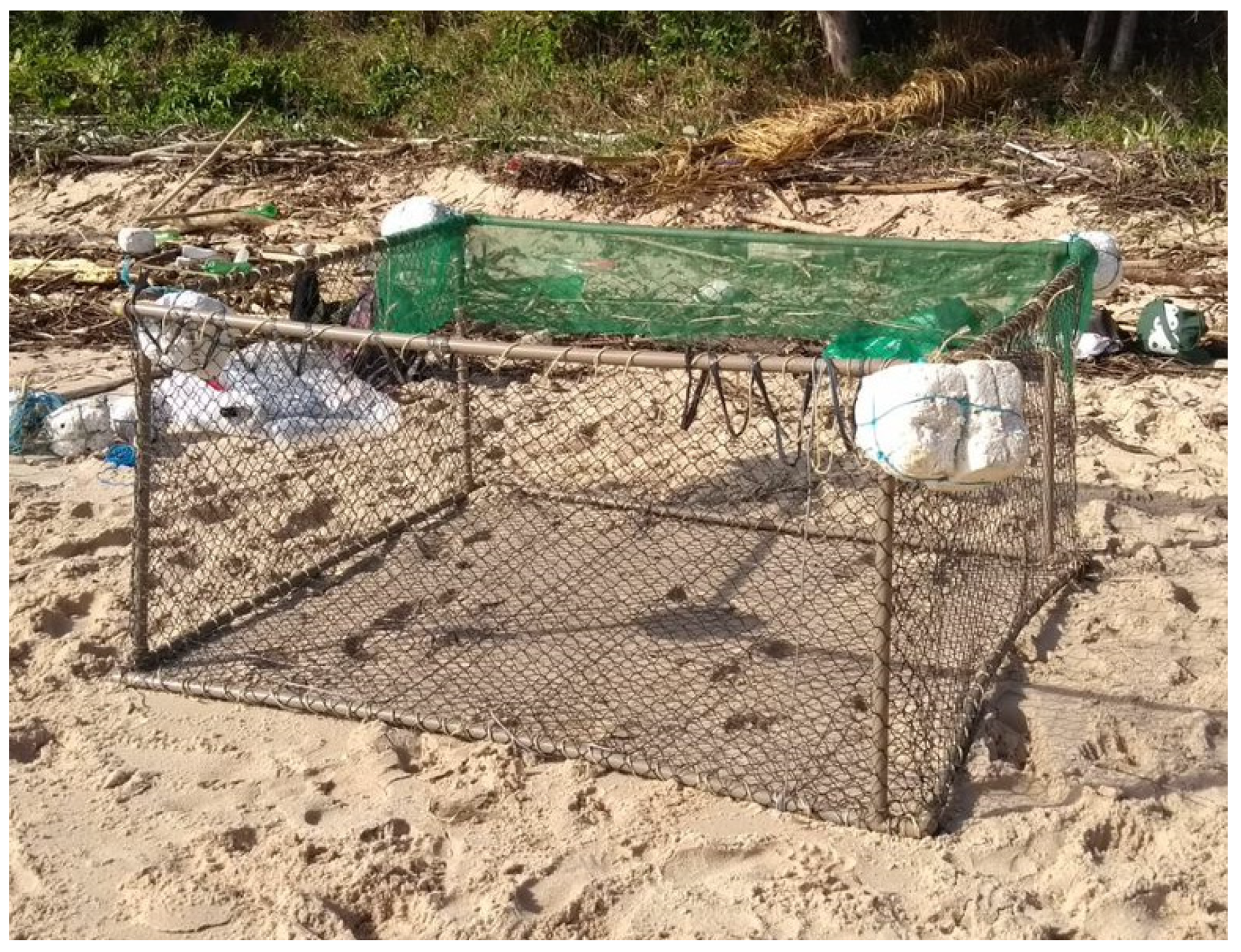
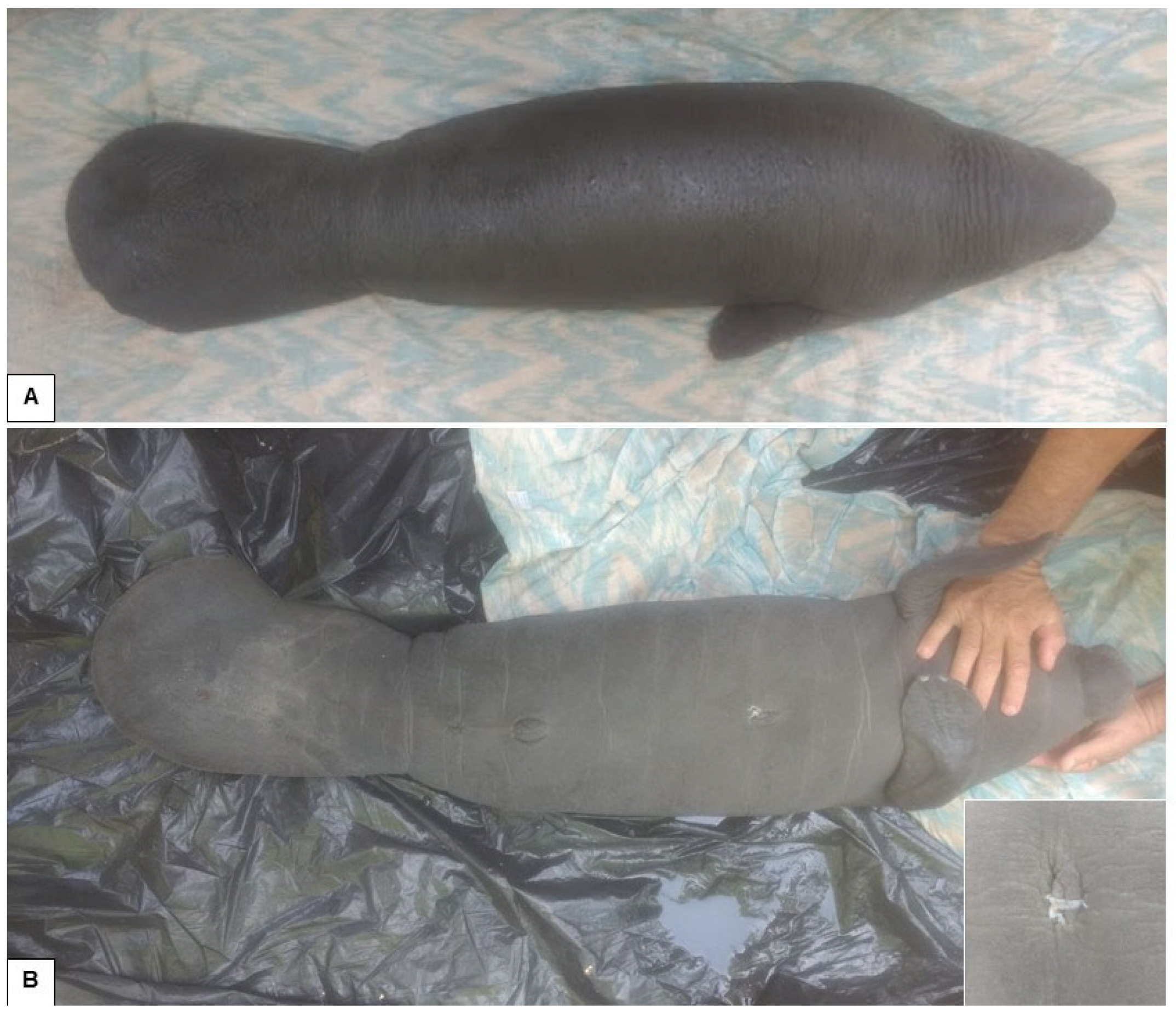

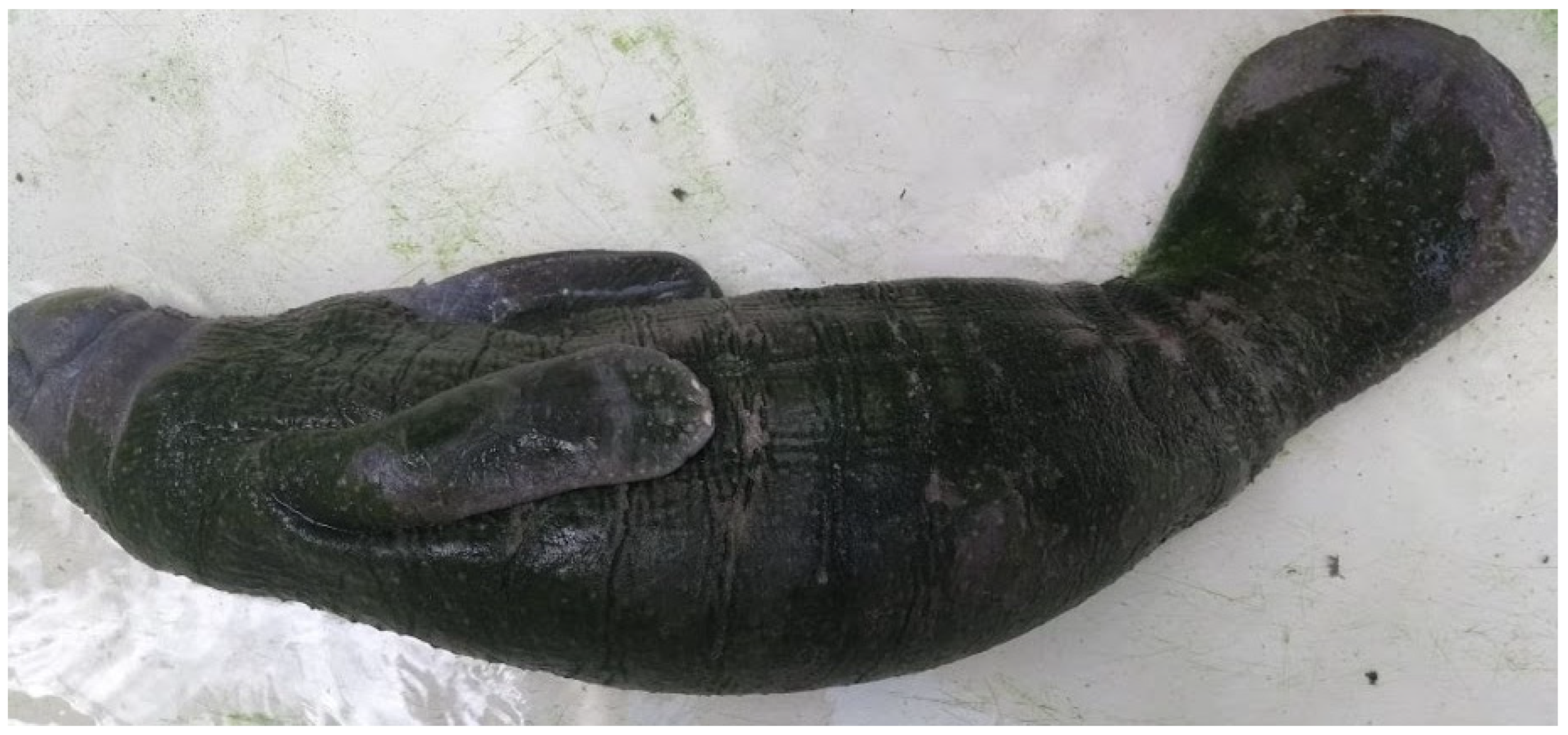
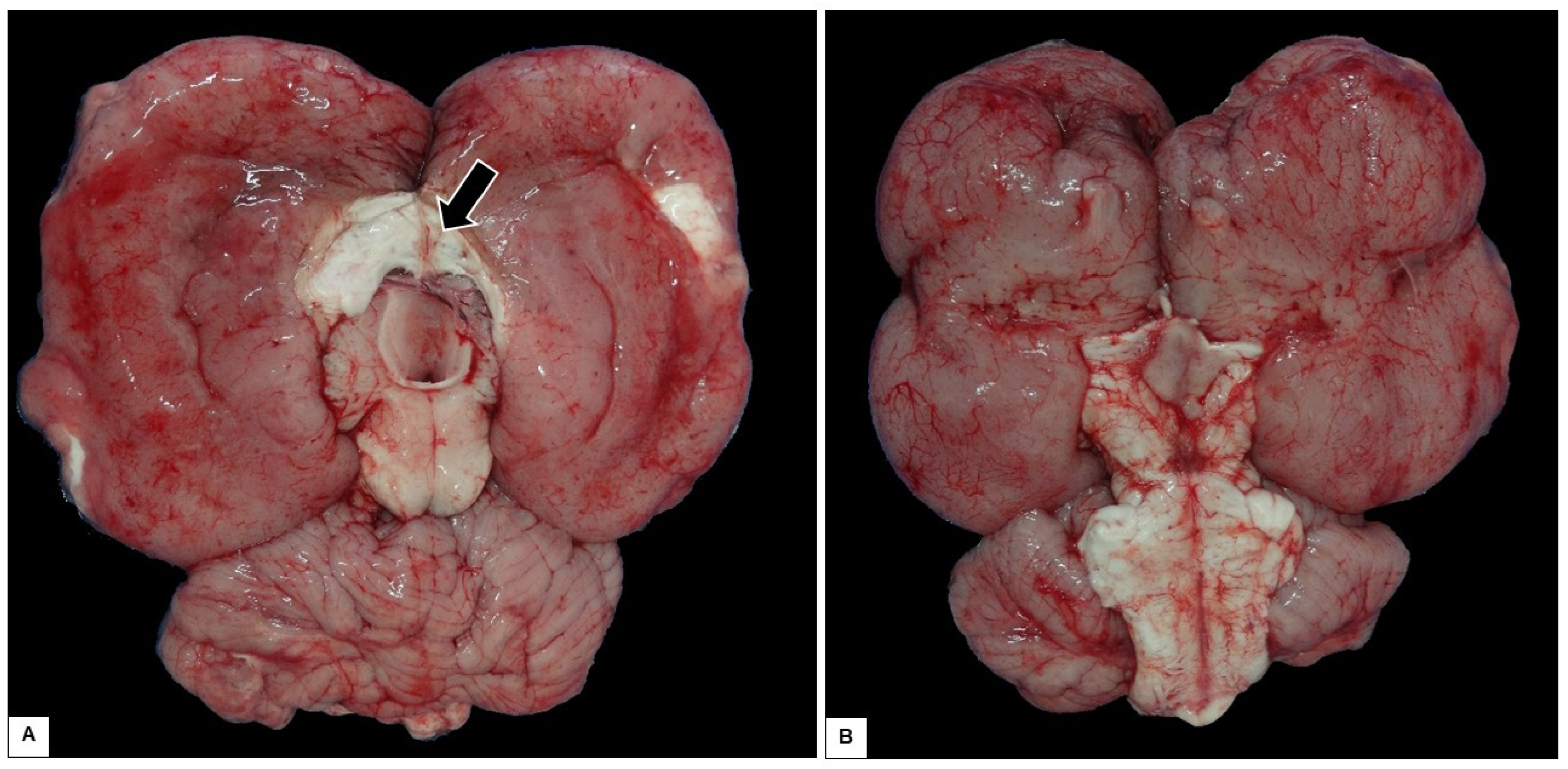
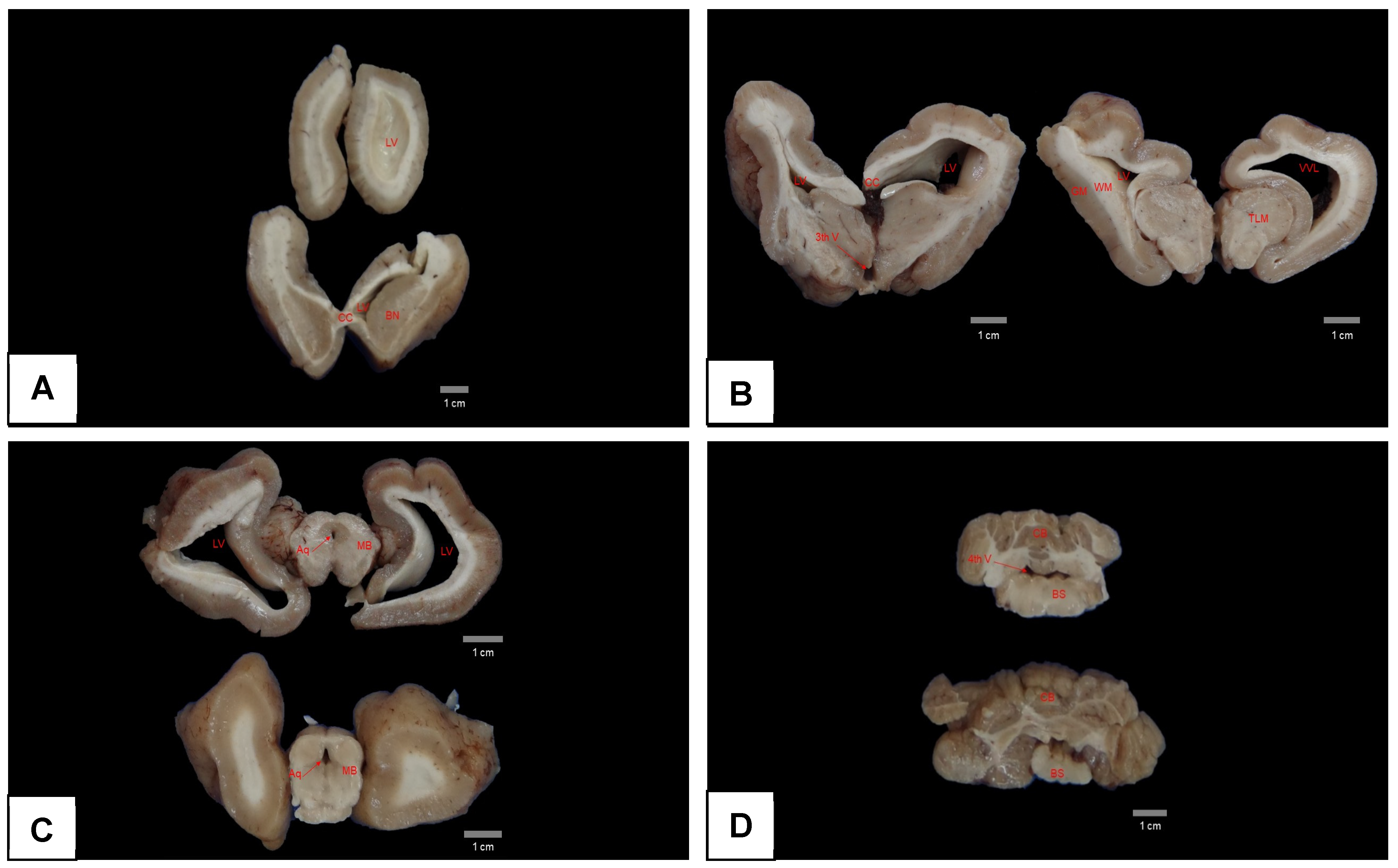

Disclaimer/Publisher’s Note: The statements, opinions and data contained in all publications are solely those of the individual author(s) and contributor(s) and not of MDPI and/or the editor(s). MDPI and/or the editor(s) disclaim responsibility for any injury to people or property resulting from any ideas, methods, instructions or products referred to in the content. |
© 2025 by the authors. Licensee MDPI, Basel, Switzerland. This article is an open access article distributed under the terms and conditions of the Creative Commons Attribution (CC BY) license (https://creativecommons.org/licenses/by/4.0/).
Share and Cite
Santos, T.F.S.; Moura, M.A.O.; Tavares, G.S.F.; Siqueira, J.S.; Sarmento, N.M.F.P.; Prado, R.G.S.; Costa, A.F.; Amaral, T.M.M.M.; Emin-Lima, R.; Sousa, M.E.M.; et al. Neonatal Abandonment and Hydrocephalus in Antillean Manatees (Trichechus manatus manatus): Is There a Causal Relationship? Animals 2025, 15, 161. https://doi.org/10.3390/ani15020161
Santos TFS, Moura MAO, Tavares GSF, Siqueira JS, Sarmento NMFP, Prado RGS, Costa AF, Amaral TMMM, Emin-Lima R, Sousa MEM, et al. Neonatal Abandonment and Hydrocephalus in Antillean Manatees (Trichechus manatus manatus): Is There a Causal Relationship? Animals. 2025; 15(2):161. https://doi.org/10.3390/ani15020161
Chicago/Turabian StyleSantos, Tiago F. S., Márcio A. O. Moura, Gabriel S. F. Tavares, Julyanne S. Siqueira, Natália M. F. P. Sarmento, Robert G. S. Prado, Alexandra F. Costa, Tayanna M. M. M. Amaral, Renata Emin-Lima, Maura E. M. Sousa, and et al. 2025. "Neonatal Abandonment and Hydrocephalus in Antillean Manatees (Trichechus manatus manatus): Is There a Causal Relationship?" Animals 15, no. 2: 161. https://doi.org/10.3390/ani15020161
APA StyleSantos, T. F. S., Moura, M. A. O., Tavares, G. S. F., Siqueira, J. S., Sarmento, N. M. F. P., Prado, R. G. S., Costa, A. F., Amaral, T. M. M. M., Emin-Lima, R., Sousa, M. E. M., Moreira Júnior, R. H. M., Bezerra Júnior, P. S., Riet-Correa, G., & Cerqueira, V. D. (2025). Neonatal Abandonment and Hydrocephalus in Antillean Manatees (Trichechus manatus manatus): Is There a Causal Relationship? Animals, 15(2), 161. https://doi.org/10.3390/ani15020161






